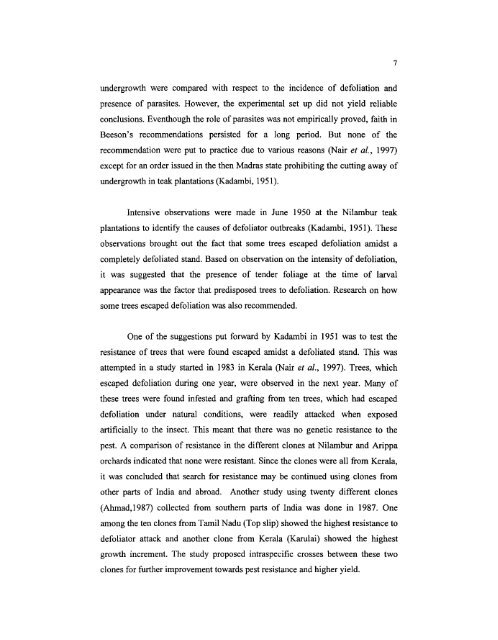Spatial dynamics of teak defoliator (Hyblaea puera Cramer) - Cochin ...
Spatial dynamics of teak defoliator (Hyblaea puera Cramer) - Cochin ...
Spatial dynamics of teak defoliator (Hyblaea puera Cramer) - Cochin ...
Create successful ePaper yourself
Turn your PDF publications into a flip-book with our unique Google optimized e-Paper software.
undergrowth were compared with respect to the incidence <strong>of</strong> defoliation and<br />
presence <strong>of</strong> parasites. However, the experimental set up did not yield reliable<br />
conclusions. Eventhough the role <strong>of</strong>parasites was not empirically proved, faith in<br />
Beeson's recommendations persisted for a long period. But none <strong>of</strong> the<br />
recommendation were put to practice due to various reasons (Nair et al., 1997)<br />
except for an order issued in the then Madras state prohibiting the cutting away <strong>of</strong><br />
undergrowth in <strong>teak</strong> plantations (Kadambi, 1951).<br />
Intensive observations were made in June 1950 at the Nilambur <strong>teak</strong><br />
plantations to identify the causes <strong>of</strong> <strong>defoliator</strong> outbreaks (Kadambi, 1951). These<br />
observations brought out the fact that some trees escaped defoliation amidst a<br />
completely defoliated stand. Based on observation on the intensity <strong>of</strong> defoliation,<br />
it was suggested that the presence <strong>of</strong> tender foliage at the time <strong>of</strong> larval<br />
appearance was the factor that predisposed trees to defoliation. Research on how<br />
some trees escaped defoliation was also recommended.<br />
One <strong>of</strong> the suggestions put forward by Kadambi in 1951 was to test the<br />
resistance <strong>of</strong> trees that were found escaped amidst a defoliated stand. This was<br />
attempted in a study started in 1983 in Kerala (Nair et al., 1997). Trees, which<br />
escaped defoliation during one year, were observed in the next year. Many <strong>of</strong><br />
these trees were found infested and grafting from ten trees, which had escaped<br />
defoliation under natural conditions, were readily attacked when exposed<br />
artificially to the insect. This meant that there was no genetic resistance to the<br />
pest. A comparison <strong>of</strong> resistance in the different clones at Nilambur and Arippa<br />
orchards indicated that none were resistant. Since the clones were all from Kerala,<br />
it was concluded that search for resistance may be continued using clones from<br />
other parts <strong>of</strong> India and abroad. Another study using twenty different clones<br />
(Ahmad,1987) collected from southern parts <strong>of</strong> India was done in 1987. One<br />
among the ten clones from Tamil Nadu (Top slip) showed the highest resistance to<br />
<strong>defoliator</strong> attack and another clone from Kerala (Karulai) showed the highest<br />
growth increment. The study proposed intraspecific crosses between these two<br />
clones for further improvement towards pest resistance and higher yield.<br />
7
















